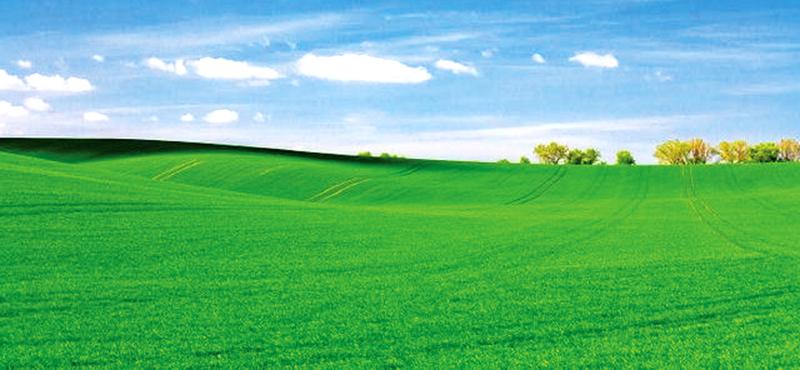
Grass is a low green plant which grows naturally over a lot of the Earth’s surface. It has very thin leaves which grow in large numbers close together. Although we do not pay much attention to grass, it is the primary source of food for domestic and wild grazing animals which feed on pastures and grasslands. Another significant use of grass is for the lawns maintained in many parts of the world. Perennial grasses are well adapted for use in lawns. This is because their basal meristems (growing points) are not lost with mowing. Very often special types of grass are used where particular considerations of soil or exposure make the more common species unsuitable. For example, buffalo grass is used where watering is restricted.
Not all grasses are beneficial, some of them are considered pests. Most of them are weeds that decrease overall production by competing with the cultivated crop, interfering with harvesting.
Lawns are mowed at regular intervals so that they are pretty to look at. However, environmentalists say mowing lawns can hurt the environment. Lawn mowers are powered by petrol, diesel or kerosene. The noxious emissions contribute to air pollution. On the other hand, mowing down native grasses along with wildflowers is likely to reduce the nectar for pollinators. Instead of mowing down all the grass in a lawn, you should allow the grass to grow in demarcated places. This is because most of us do not want to let our lawns become a full-grown meadow. The demarcated places where grass is allowed to grow would naturally attract bees, butterflies and other insects which are nature’s wonderful creations.
Meadows
Meadows where grass and wild flowers grow together in harmony occur naturally and survive solely on rainwater and dew. You can create a little meadow in your garden by using drought-resistant and native plants that would cut down the amount of water needed to maintain your landscape. Even if you do not water the meadow, you can let nature run its course. Mowing the lawn and cutting down the trees around your house has resulted in a sharp drop in the number of pollinators during the past few decades. The use of pesticide and petrol has also contributed to the drop. We need pollinators to get crops from plants. For this we have to pick nectar-rich plants to give them plenty of pollinating power.
The little meadow you are going to create does not need regular cleaning. You should allow the dead leaves, stems and stalks to settle down on the Earth. This will help birds to find food and nesting materials. If you want more birds to come to your meadow, pick seedy plants or try some native grasses. Birds are attracted to the convenient food source and ample material for nesting.
The air is already polluted with vehicle emissions, livestock and factory fumes. When you use your lawn mower you are adding to the disaster. If you mow less, you can reduce the air pollution to some extent. At least switch to a cleaner and more eco-friendly battery-operated lawn mower.
Benefits
There are additional benefits of having a meadow in your garden. Some meadow plants produce amazing flowers which can be kept in a vase for many days. Many of these plants self-seed creating more flowers with little to no effort from you.
The so-called civilized people do not like to see grass growing in their compounds and the backyard. They either remove all the grass and use cement blocks or destroy it by using machines or harmful chemicals. Uneducated villagers do not do so. They allow the grass to grow freely around their wattle and daub huts. They reach their fields walking on dew-filled grass early in the morning. In the cities grass is grown in certain parks and nobody is allowed to trample on it.
I have allowed all kinds of unwanted plants to grow lavishly in a small portion of my land. There are a few papaw trees, a karapincha tree, and some beautiful wild plants laden with tiny but beautiful flowers. I watch through the window the bees and other insects that visit my little meadow. This unattended lush green patch is more beautiful than a plot of land designed by a competent landscape artist.
Terra firma
Those who live in flats and apartments probably do not give much thought to grass. But when they come to the terra firma, strange thoughts run through their minds. They would at once be struck by its mysteries, and wonder why they are compelled to live in the asphalt jungle where grass does not grow. We can learn a few lessons from grass. Grass has a simple way of life. It does not ask anything from you. A drop of rain will quench its thirst. Even if you cut or trample it, grass will not complain.
Grass roots are typically fibrous and go down to the Earth. They extend into the soil like fingers collecting nutrients, soaking up water and securing the plant to the ground. Grass leaves alternate in direction. That means if the first leaf grows to the right, the second leaf will grow to the left. Like the leaves on a tree, grass collects energy from sunlight through photosynthesis. The photosynthesizing chlorophyll in the leaf gives grass its green colour.
Grass continues to grow even after mowing. In addition, it can withstand burning, grazing and trampling. This does not mean that you should mow the lawn regularly to maintain its beauty. Let some grass grow naturally in a particular place so that you can walk on it every morning. Grass laden with dew will refresh your tired feet naturally and effectively. In order to derive maximum benefits, walk on the grass barefoot. Whenever I read J. Vijayatunga’s classic ‘Grass for My Feet’ I feel an urge to walk on grassy lands.
